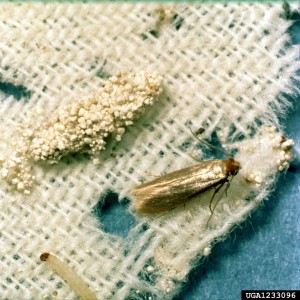You Might Need Help With Clothes Moth Infestation
By Chris Williams on January 1, 2015.
I just saw your blog, “White Worms Crawling Up the Walls!” I have found these worms in my pillows and bedroom walls. I’m guessing these are the same thing because we had a moth problem at the beginning part of the year. I stay in an old house with shaggy carpet. What can I do?? Especially if I can’t afford an exterminator? – Kendra
Kendra, that blog was about Indianmeal moth larvae, which are pests of stored food products. Although these whitish worms can be found in rooms outside of the kitchen, I don’t think that’s what you are dealing with here.
I wouldn’t expect to find food larvae inside pillows unless the pillows were stuffed with grain hulls or something similar. However, you could find clothes moth larvae inside pillows if they were stuffed with feathers, down, hair or some other natural fill. Clothes moths don’t just feed on woolen clothing. They can also infest feathers, wool or wool blend rugs, furs, hair, and hides (even mounted trophy heads).
And since you mention the old carpet, clothes moth larvae could feed on the carpet or its backing if it is made of wool or animal fibers. It’s also interesting that you mention the worms being in your walls because back in the old days (you say the house is old), they did often use horse hair inside walls for insulation, or mixed horse hair into plaster to cover the walls.
Make Sure You Know Your Pest
The first thing you need is a professional pest identification since treating for clothes moths and treating for food pests are two very different things. If you don’t want to contact a pest control company, you may be able to get the worms (or moths) identified by your country extension agent (look in your phone book under county government or click the previous link).
The second thing you need is an inspection. Clothes moths can feed on so many different things that it would be difficult for you to know where to look. Since it sounds like the infestation has gone on for some time, the moths are likely in other rooms of the house as well.
You Need Expert Knowledge for an Extensive Infestation
Basically, control means finding each and every place where clothes moth larvae are feeding and developing. Depending on the infested item, clothes moths and their eggs can sometimes be killed by dry cleaning, freezing, or fumigating the item. Treating infested clothing is one thing, but if clothes moths are infesting on a large scale or are infesting many different items, you’re going to need professional help. Trying to spray for clothes moths with insecticide is not easy since the adult moths and the larvae are found in different places (the adults don’t feed on clothes or wool). Pheromone traps can sometimes be used to capture the adult moths.
For more on control of clothes moths, check out these blogs:
Photo: Clemson University – USDA Cooperative Extension Slide Series, Bugwood.org
Stay up-to-date with Colonial Pest’s email newsletter!
